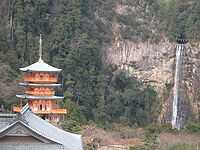Kumano shrine

Kumano Sanzan

The religious significance of the Kumano region goes back to prehistoric times and therefore predates all modern religions in Japan.[3] The area was, and still is, considered a place of physical healing.[3] Each shrine initially had its own separate form of nature worship, but in the 10th century, under the influence of Buddhism, the three came to be worshiped together as the three deities of Kumano.[3] Because at the time Japanese kami were believed to be emanations of Indian buddhas (honji suijaku theory), the three came to be associated with the Buddhas Amida Nyorai, Yakushi Nyorai and Senju Kannon.[2] The site became, therefore, a unique example of fusion between Buddhism and Japanese original cults (see the article Shinbutsu shūgō).[3] Thereafter the Kumano Sanzan site attracted many worshipers and became a popular pilgrimage destination.[2] In the 11th century pilgrims were mostly members of the Imperial family or aristocrats, but four centuries later they were mostly commoners.[3] Pilgrims were called the "Kumano ants" (蟻の熊野) because they could be seen winding through the valleys like so many ants.
Other important Kumano shrines
- Kumanotaisha Shrine (Yamagata) (Nanyo, Yamagata)
- Kumanotaisha Shrine (Shimane) (Matsue, Shimane)
- Kumano Kōdai Shrine (Karuizawa, Nagano)
Notes
References
- Kumano Sanzan accessed on December 1, 2008
- Japanese Wikipedia article "ja:熊野神社" accessed on June 12, 2008
- D. Max Moerman, Localizing Paradise: Kumano Pilgrimage and the Religious Landscape of Premodern Japan. Harvard University Press, 2004. ISBN 0674013956
- Sacred site "Kumano Sanzan" accessed on June 12, 2008